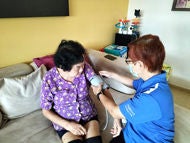What is - Intermittent Catheterisation
Guide for Caregivers
- What is intermittent catheterisation?
- Preparing the required items
- Preparations before the procedure
- Inserting the catheter (for males)
- Inserting the catheter (for females)
- Removing the catheter
- Washing and drying the catheter after the procedure
- Storing the catheter
-
Reusing the catheter
-
Draining urine overnight (For children and adolescents)
This content is developed in collaboration with the following partners:








1. What is intermittent catheterisation?
It is the insertion and removal of a catheter into the urethra several times a day to empty the bladder.
2. Preparing the required items

- Catheter and kidney dish (refer to picture 1)
- Measuring jug with units in ml (refer to picture 2)
- Water-based lubrication gel
- Notebook for recording
Reminder
Perform the catheterisation at regular intervals as ordered by the doctor or nurse.
For children and adolescents
As per recommendations by the doctor or nurse:
- Use appropriate catheter size
- Use Lignocaine 2% gel
- If urine needs to be drained overnight:
- Two-inch micropore tape (refer to picture 3)

- Double diapers or urine bag (refer to picture 4)

- Alcohol swabs
- Two-inch micropore tape (refer to picture 3)
Caregiver preference:
- Alcohol free hygiene wipes for perineum cleaning
- Sterilising tablets for reusing of catheter or urine bag
3. Preparation before the procedure
- Wash your hands thoroughly with soap and water.
- Wash the genital area with soap and water.
- For uncircumcised male, pull back the foreskin before washing (refer to picture 6).
- Apply lubrication gel from the tip of the catheter (refer to picture 5). Lubrication length to be recommended by the doctor or nurse.

- Place the patient in the most comfortable position that is convenient for you.
If you encounter problems while inserting the catheter, the following tips may help:
-
If the catheter does not go in
- Instruct the patient to take a deep breath and contract the abdominal muscles as if trying to urinate.
-
If contracting abdominal muscles does not help
- Remove the catheter fully, ask patient to breathe deeply and relax for 5 minutes.
- Try again.
-
If there is sharp pain
- Remove the catheter and seek medical attention immediately.
4. Inserting the catheter (for males)

a. Hold the penis upwards at a 60°angle, to straighten the urethra.

b. Slowly insert the catheter. Stop advancing the catheter when urine starts flowing.

c. Lower the angle of the penis to drain the urine into the kidney dish.
5. Inserting the catheter (for females)

a. Part the labia with the index and middle fingers of your non-dominant hand.

b. Slowly push the lubricated catheter into the urethra opening until urine is seen flowing out.

c. Lower the angle of the catheter to drain the urine into the kidney dish.
6. Removing the catheter
- Withdraw the catheter slowly when the urine stops flowing.
- For uncircumcised males, push back the foreskin gently after removing the catheter (refer to picture 6).

- Wash your hands after the procedure.
- Measure and record the amount of urine.
Reminder
- Note the urine colour (yellowish, brownish, or reddish). If the urine is cloudy or has a strong or foul odour, record it down in a notebook. If it persists for more than 24 hours, consult the doctor immediately.
- Show the notebook to the doctor or nurse on the day of review.
7. Washing and drying the catheter after the procedure

- Wash the catheter under running water with or without mild soap as shown (refer to picture 7).
- Shake off any excess water and dry it with clean tissue paper.
For children and adolescents
Caregiver preference:
- Alcohol free hygiene wipes for perineum cleaning.
- Sterilising tablets for reusing of catheter or urine bag.
8. Storing the catheter
- Keep the catheter in a clean plastic container with a lid (refer to picture 8). If a Ziploc bag is used, ensure it is changed daily.

- Store it in a cool and dry place to be ready for the next use.
- Wash your hands after the procedure.
9. Reusing of the catheter
- Change the catheter as instructed by the doctor or nurse.
10. Draining urine overnight (For children and adolescents)
- Secure the catheter with a micropore tape and clean the catheter drainage opening using an alcohol swab (refer to picture 9).

- Connect the catheter to a new urine bag OR lay the catheter drainage opening on the double diapers (refer to picture 10).

- Remove the catheter after completion of the overnight drainage.
- Dispose the urine bag or double diapers.
Caregiver preference:
- If a urine bag is reused,
- Wash and rinse it with soap and water or sterilising solution and hang it to dry
- Clean the connection port of the urine bag before connecting it to a catheter (refer to picture 11)

- Change the urine bag as instructed by the doctor or nurse

General
Diet
- Ensure the patient follow the usual diet and consume plenty of fruits and vegetables to prevent constipation.
- Constipation may cause difficulty in passing urine. If constipation is a problem, please consult the doctor or nurse for advice.
Fluid intake
- DO NOT reduce the patient’s fluid intake to avoid catheterisation unless instructed by the doctor or nurse.
-
For adults
Encourage the patient to drink about 2 litres or 7-8 glasses of water daily. -
For children and adolescents
Drink adequate water daily:- 1.2 litres (less than 2 years old)
- 1.2 to 1.4 litres (2 to 7 years old)
- 1.4 to 1.6 litres (7 to 12 years old)
- 1.6 to 1.8 litres (12 years old and above)
Intermittent Catheterisation
Preparing for catheterisation
- Follow catheterisation schedule.
- Urinate before catheterisation
- For adults: Encourage the patient to urinate (if possible) before any catheterisation.
- For children and adolescents: Seek advice from the doctor or nurse.
- Instruct the patient to relax when inserting the catheter (tensed muscles make the catheter harder to insert).
CONTACT US IMMEDIATELY IF YOU HAVE:
- Difficulty or increasing pain when inserting the catheter
- Difficulty or inability to urinate
- Bloody urine (a trace of blood is normal)
- Swelling of the abdomen
- Prolonged discomfort or pain
- Redness of skin around penis/scrotum (for males)
- Signs of infection such as:
- Foul-smelling urine, or presence of sand-like grains in your urine
- Persistent fever of more than 38°C or chills
- Pain in your lower back or lower abdomen
Contributed by
The information provided is not intended as medical advice. Terms of use. Information provided by SingHealth.






















